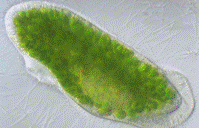Biological Sciences, School of

School of Biological Sciences: Faculty Publications
Document Type
Article
Date of this Version
2003
Abstract
One way of addressing the question of whether some species are expendable is to ask what role, if any, a minor species, even one that seems obnoxious, plays in the functioning of its community. Thistles (Cirsium spp.) are prickly plants native to North America that are numerically minor and are often considered unattractive or undesirable. So, thistles might be considered expendable. Yet, can we assume that such minor, seemingly undesirable species can be elirninated without disrupting important interdependencies or losing key ecological services? Our long-term studies of thistle-insect interactions are beginning to provide evidence that even such species may play important, unexpected roles in ecological dynamics and in economic welfare. These studies suggest that determining the cost of losing a species requires criteria other than relative abundance and general attractiveness. In this chapter, we summarize the natural history of the native Cirsium species, which we study in the upper Great Plains. Then, we briefly review experimental evidence that the native insects that feed on native thistles can restrict their abundance and weediness. Finally, we present new observational data suggesting that these native insects, moving over from a native species such as tall thistle (Cirsium altissimum (L.) Spreng.), are likely involved in limiting the invasion of bull thistle, Cirsium vulgare (Savi) Ten., in the tallgrass prairie region of Nebraska. Bull thistle is a Eurasian species that is highly invasive elsewhere (Austin et al. 1985; Randall 1991; Julien and Griffiths 1998; Olckers and Hill 1999) and often becomes expensive to control in agronomic regions around the world. Such invasions of nonindigenous species can present major economic and ecological threats to ecosystem structure and functioning (Mooney and Drake 1986; Drake et al. 1989; Simberloff et al. 1997). We hypothesize that our study represents a case of a numerically minor species that, acting as a reservoir of native insects, provides an ecologically and economically valuable ecosystem service: resistance to invasion by an alien weed. The case also suggests that more research on the potential biotic resistance provided by natural enemies may help us better understand those factors that influence whether an alien species becomes invasive after naturalization.
Based on our studies, we argue that there are practical as well as aesthetic and ethical reasons for working to maintain minor, even seemingly obnoxious, species and their interactions. In particular, this case suggests that we are not yet in a position to predict the cost associated with the decline and loss of a specific species, since its ecological function and economic value may not be obvious.


Comments
Published in P. Kareiva and S. Levin, editors, THE IMPORTANCE OF SPECIES, Princeton University Press, 2003. Copyright 2003 Princeton University Press.